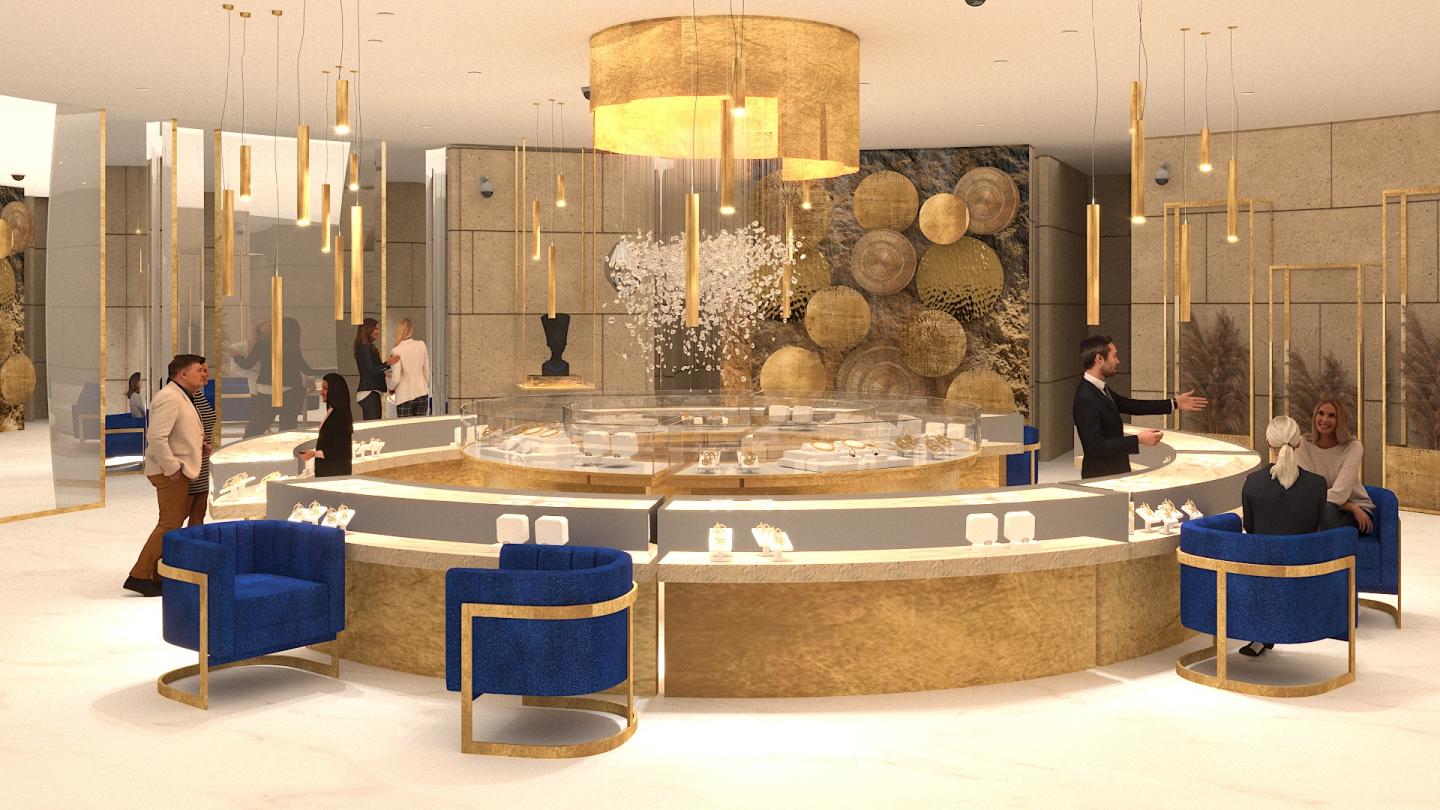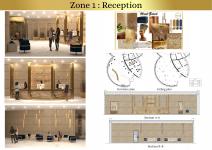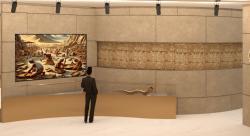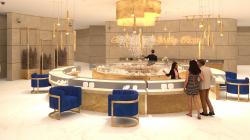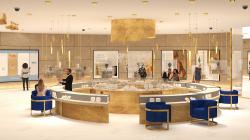El Sukari Jewellery Centre is an interior design project dedicated to empowering Egyptian jewelry brands through a carefully curated spatial experience. Located in 6th of October City, the center serves as a platform where tradition meets innovation—bridging Ancient Egyptian heritage with contemporary interior solutions. Named after Egypt’s most iconic gold mine, "El Sukari," the project celebrates both the cultural legacy of Egyptian gold and the modern craftsmanship of local designers.
The conceptual foundation is rooted in the symbolism of the Ouroboros, an ancient Egyptian emblem representing the eternal cycle of creation and transformation. This circular motif informs the spatial organization of the project, guiding the visitor through a seamless, narrative-driven journey from reception, to exhibition, to retail. The overall aim is to establish a strong identity for Egyptian jewelry in the global market, while also offering a space that educates, inspires, and connects.
The design addresses several gaps in typical jewelry environments: lack of immersive storytelling, poor display systems, and disconnection between product, brand, and visitor. The El Sukari Centre responds by creating an immersive atmosphere that supports both commercial visibility and cultural appreciation.
Zone 1 – Reception Area
The reception acts as the ceremonial gateway to the center. It’s designed to create an immediate emotional connection through materiality, lighting, and symbolism. Featuring warm-toned natural stone, gold accents, and subtle references to ancient temple entrances, the space is both welcoming and iconic. An interactive digital screen or sculptural centerpiece introduces visitors to the journey ahead. The circular spatial logic begins here, subtly hinting at the Ouroboros concept, setting the stage for exploration and engagement.
Zone 2 – Exhibition Area
The exhibition area forms the narrative core of the project. It guides visitors through the story of gold in Egypt—spanning five distinct chapters:
The history of gold in Ancient Egypt
Traditional mining tools and techniques
Cultural and symbolic uses of gold
Historic gold collectibles
A digital storytelling room highlighting the journey and meaning behind each piece
Each section is designed with interactive display technologies such as motion-triggered screens, digital storytelling via RFID tags, and atmospheric lighting that shifts with each theme. The spatial layout follows a soft, circular flow that supports slow exploration and discovery. Wall niches, sculptural pedestals, and smart showcases create an intimate dialogue between artifact and observer. This zone connects past, present, and future in a poetic yet practical sequence.
Zone 3 – Retail Shop
This zone is where commerce meets curation. Designed as a luxury retail environment, it allows contemporary Egyptian jewelry brands to showcase their work in a setting that reflects their craftsmanship and identity. The retail shop features modular displays, anti-reflective glass cases, and custom lighting optimized to enhance the brilliance of each piece. Storytelling is embedded into the retail experience through interactive tags that share details about the designer, inspiration, and making process. The retail shop balances elegance with accessibility, encouraging both admiration and purchase. The material palette continues the warm, gold-inspired tones, creating a cohesive identity across all zones.
El Sukari Jewellery Centre is more than just a showroom—it’s a celebration of legacy, an engine of local empowerment, and a vision for the future of Egyptian design. Through intentional zoning, symbolic design language, and advanced display strategies, the space redefines how jewelry is experienced, valued, and remembered.
2025
Materials & Finishes:
Materials were selected for their symbolic, functional, and sustainable properties. Natural sandstone inspired by ancient Egyptian architecture, recycled metals, and treated wood are used throughout to echo the historical and material origins of jewelry. Showcase materials are anti-reflective and secure, ensuring clarity and protection of delicate pieces. Finishes are warm, earthy, and textured—evoking the richness of gold and the natural Egyptian landscape. The material palette creates a tactile, inviting environment that honors both tradition and innovation.
Lighting Strategy:
A layered lighting approach was adopted to balance product visibility with overall ambiance. Adjustable spotlights are used to highlight individual jewelry pieces with precision, while ambient lighting softens the environment and evokes the sacred atmosphere of ancient temples and artisan workshops. The lighting design enhances the emotional tone of each space, supporting both functionality and storytelling.
Technology & Interaction:
Each piece or exhibit is enhanced through integrated RFID tags and interactive digital screens. Visitors can scan individual items to discover details about their design story, creator, and inspiration—transforming the space into a smart, narrative-rich environment. The retail zone includes advanced inventory and sales management systems, allowing brands to operate efficiently. Within the exhibition, projection mapping and audio narration add layers of sensory engagement, bridging history and modernity.
Furniture & Custom Elements:
Custom-designed furniture elements reinforce the space’s identity and functional needs. These include circular reception desks symbolizing the Ouroboros, modular retail displays that can adapt to different brand collections, and ergonomic workbenches tailored for artisans. All furnishings incorporate rounded edges for safety, matte finishes to avoid glare, and authentic textures such as polished stone, brushed metals, and tactile fabrics that resonate with the project's handcrafted essence.
Safety, Security & Systems:
Safety and security are critical components of the design, particularly given the high-value nature of jewelry. The layout includes wide, clear circulation paths, slip-resistant flooring, and rounded corners on all built-in furniture to minimize physical hazards. Lighting levels are carefully balanced to ensure both display quality and visibility for safe navigation.
A comprehensive security strategy is embedded across all zones. The reception features a monitored entry point with access control to regulate visitor flow. Discreet surveillance cameras cover key public and restricted areas, while display cases are equipped with tamper-proof locking systems. The space also supports integration with alarm systems and after-hours lockdown protocols. Security staff areas and control rooms are planned within the back-of-house layout for operational efficiency.
Fire safety systems—including sprinklers, smoke detectors, and clearly marked emergency exits—are incorporated throughout the project in compliance with building regulations.
Mechanical and electrical systems are zoned for optimal energy use and thermal comfort. HVAC systems maintain appropriate temperatures to preserve sensitive materials, while ventilation ensures healthy indoor air quality. All systems are seamlessly integrated into the architectural framework to maintain a clean, cohesive visual language.
Project Title: El Sukari Jewellery Centre
Location: 6th of October City, Giza, Egypt
Project Type: Interior Design – Commercial / Retail
University: MSA University – Faculty of Arts and Design
Academic Year: 2024–2025
Design Software Used: AutoCAD, 3DS Max, Adobe Photoshop, V-Ray Renderer
Supervising Professors:
Prof. Dr. Khaled Hawas
Prof. Dr. Ola Hashem
Prof. Dr. Amany Mashhour
Prof. Dr. Hoda Gad
Dr. Tarek Fouad
Teaching Assistants & Support Team:
A.L. Ghada Ammar
A.L. Fatma Zakaria
T.A. Dalia Fekry
T.A. Maryam El-Gohary
T.A. Merihane Jebari
T.A. Rawan Yasser
